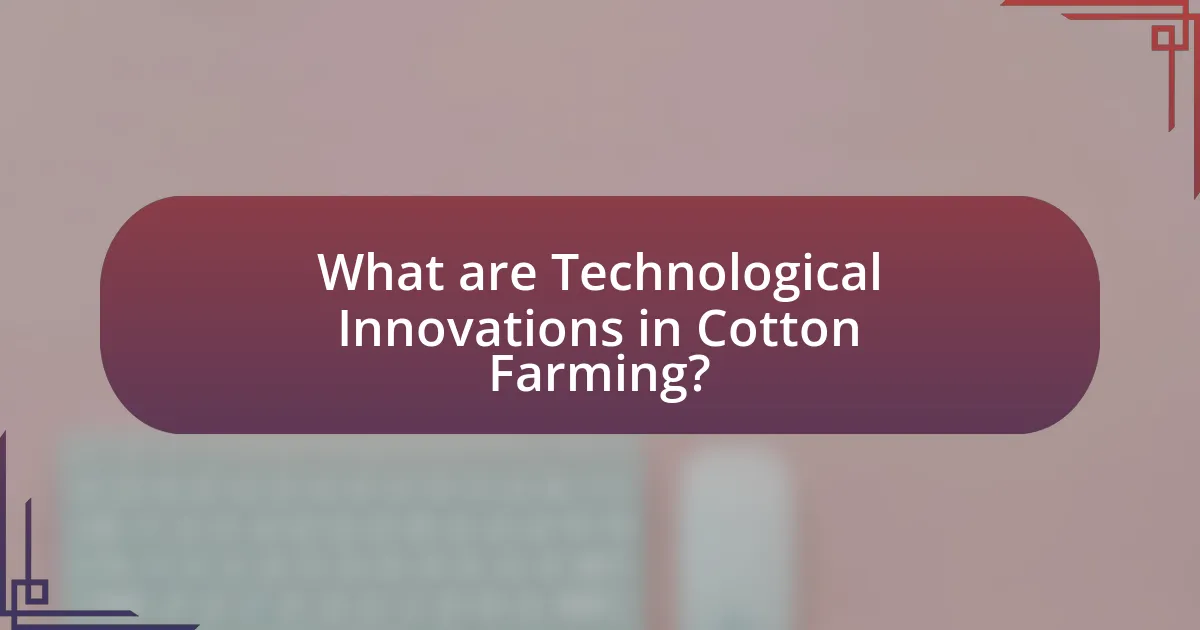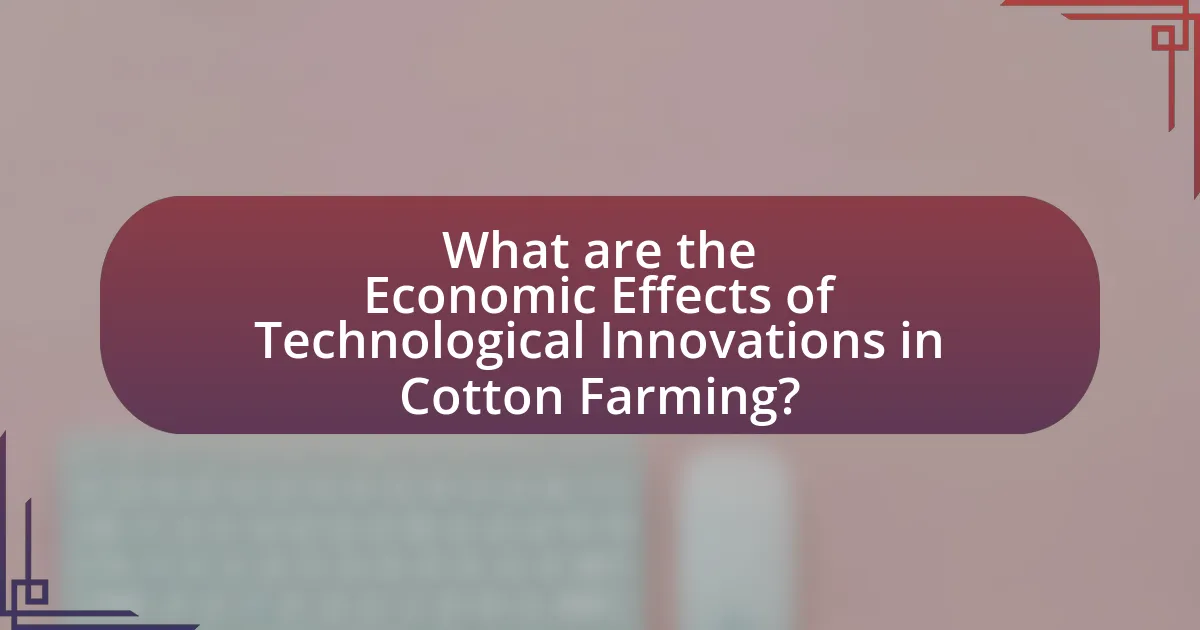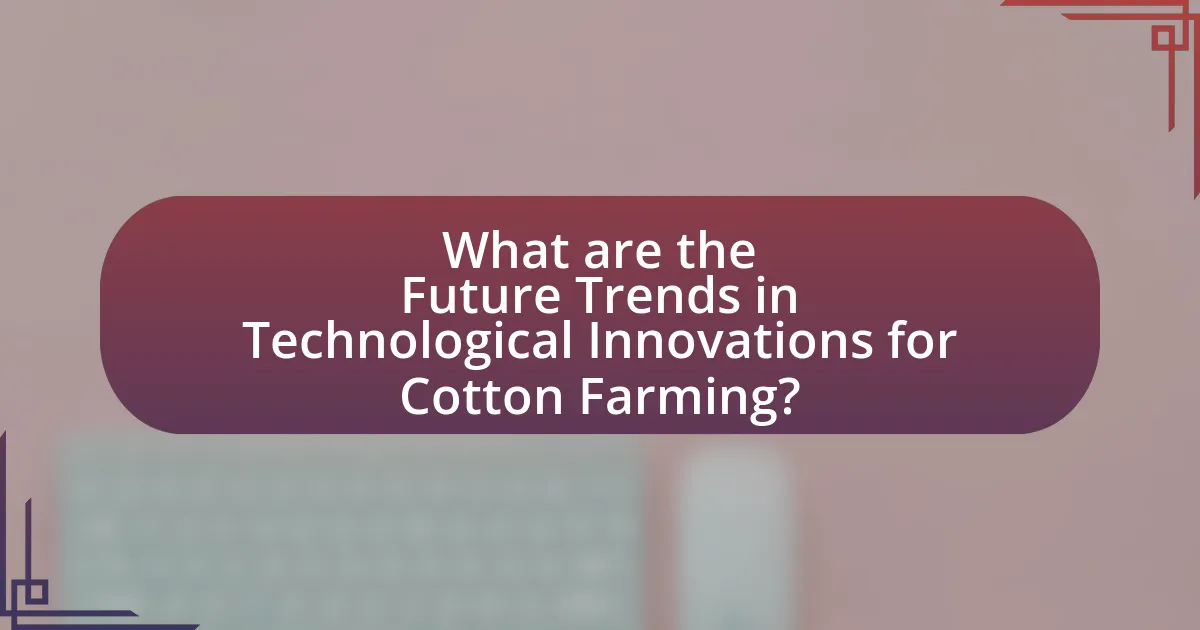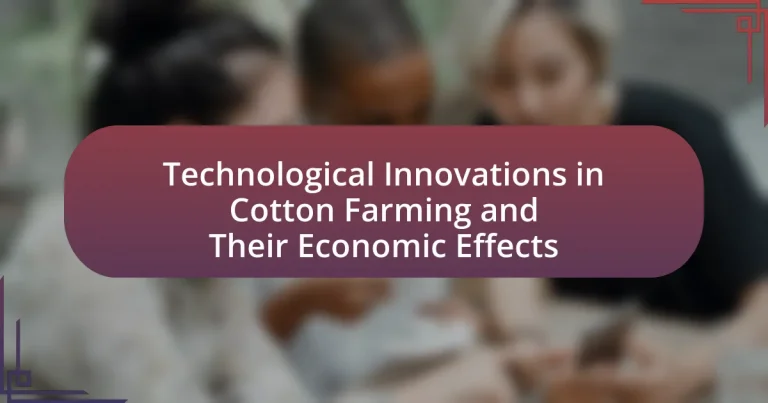Technological innovations in cotton farming, including precision agriculture, genetically modified organisms (GMOs), and automated machinery, are transforming agricultural practices and enhancing economic outcomes. Precision agriculture utilizes data analytics and GPS technology to optimize planting and resource use, resulting in increased yields and reduced costs. GMOs, such as Bt cotton, improve pest resistance and lower pesticide usage, while automated systems streamline labor-intensive processes. These advancements not only boost productivity but also contribute to sustainability, addressing challenges faced by traditional farming methods and positively impacting local and global cotton markets. The article explores these innovations and their economic effects, highlighting the importance of adopting new technologies for improved profitability and environmental stewardship in cotton farming.

What are Technological Innovations in Cotton Farming?
Technological innovations in cotton farming include precision agriculture, genetically modified organisms (GMOs), and automated machinery. Precision agriculture utilizes data analytics and GPS technology to optimize planting, irrigation, and harvesting, resulting in increased yields and reduced resource waste. GMOs, such as Bt cotton, are engineered to resist pests and diseases, leading to lower pesticide use and higher profitability for farmers. Automated machinery, including drones and robotic harvesters, enhances efficiency and reduces labor costs. These innovations collectively contribute to improved productivity and sustainability in cotton farming, as evidenced by studies showing that GMO cotton can increase yields by up to 30% compared to non-GMO varieties.
How have technological advancements transformed cotton farming practices?
Technological advancements have significantly transformed cotton farming practices by enhancing efficiency, increasing yields, and improving sustainability. Precision agriculture technologies, such as GPS-guided equipment and drones, allow farmers to monitor crop health and optimize resource use, leading to a reported 10-20% increase in cotton yields. Additionally, genetically modified cotton varieties have been developed to resist pests and diseases, reducing the need for chemical pesticides and lowering production costs. According to the International Cotton Advisory Committee, the adoption of these technologies has contributed to a 30% reduction in water usage per kilogram of cotton produced, demonstrating a clear shift towards more sustainable farming practices.
What specific technologies are currently being utilized in cotton farming?
Currently, precision agriculture technologies are being utilized in cotton farming, including GPS-guided equipment, drones, and soil sensors. These technologies enhance efficiency by enabling farmers to monitor crop health, optimize irrigation, and apply fertilizers and pesticides more accurately. For instance, GPS-guided tractors allow for precise planting and harvesting, reducing waste and increasing yield. Drones equipped with imaging technology can assess crop conditions and identify pest infestations, leading to timely interventions. Soil sensors provide real-time data on moisture levels, helping farmers make informed irrigation decisions. These advancements contribute to higher productivity and sustainability in cotton farming.
How do these technologies improve efficiency and yield in cotton production?
Technologies such as precision agriculture, genetically modified organisms (GMOs), and automated machinery significantly improve efficiency and yield in cotton production. Precision agriculture utilizes data analytics and GPS technology to optimize planting, irrigation, and fertilization, leading to reduced resource waste and increased crop output. GMOs are engineered for traits like pest resistance and drought tolerance, which enhance survival rates and yield potential under varying environmental conditions. Automated machinery, including drones and robotic harvesters, streamlines labor-intensive processes, reduces operational costs, and minimizes crop damage during harvesting. For instance, studies have shown that the adoption of precision agriculture can increase cotton yields by up to 20% while reducing water usage by 30%, demonstrating the tangible benefits of these technological advancements.
Why is it important to adopt new technologies in cotton farming?
Adopting new technologies in cotton farming is crucial for enhancing productivity and sustainability. Modern technologies, such as precision agriculture, genetically modified organisms (GMOs), and advanced irrigation systems, enable farmers to optimize resource use, reduce costs, and increase yields. For instance, the use of GMOs can lead to higher resistance against pests and diseases, resulting in a 20-30% increase in cotton yields, as reported by the International Service for the Acquisition of Agri-biotech Applications. Furthermore, precision agriculture techniques can reduce water usage by up to 30%, addressing the critical issue of water scarcity in farming. These advancements not only improve economic viability for farmers but also contribute to environmental sustainability by minimizing chemical inputs and conserving natural resources.
What challenges do traditional cotton farming methods face?
Traditional cotton farming methods face significant challenges, including susceptibility to pests and diseases, soil degradation, and water scarcity. These methods often rely on chemical pesticides, which can lead to resistance in pests and harm beneficial insects, ultimately reducing crop yields. Additionally, traditional practices may not incorporate sustainable soil management techniques, resulting in nutrient depletion and erosion. Water scarcity is exacerbated by climate change, making it difficult for farmers to maintain adequate irrigation for cotton crops. According to the Food and Agriculture Organization, cotton production is highly water-intensive, with some regions requiring over 7,000 liters of water to produce just one kilogram of cotton. These challenges highlight the need for innovative agricultural practices to enhance sustainability and productivity in cotton farming.
How can technology address these challenges?
Technology can address challenges in cotton farming by enhancing efficiency, improving crop yields, and reducing resource consumption. Precision agriculture technologies, such as GPS-guided equipment and drones, enable farmers to monitor crop health and optimize inputs like water and fertilizers, leading to a reported 10-30% increase in yields (source: “Precision Agriculture: A Global Perspective,” by Robert J. F. and others, 2021). Additionally, biotechnology advancements, including genetically modified cotton varieties, have demonstrated resistance to pests and diseases, resulting in a 20% reduction in pesticide use (source: “Economic Impact of Genetically Engineered Crops,” by the National Academies of Sciences, Engineering, and Medicine, 2016). These technological innovations not only enhance productivity but also contribute to sustainable farming practices, addressing environmental concerns associated with traditional cotton farming methods.

What are the Economic Effects of Technological Innovations in Cotton Farming?
Technological innovations in cotton farming significantly enhance productivity and profitability. For instance, the adoption of genetically modified organisms (GMOs) has led to increased yields, with studies showing that GMO cotton can produce up to 30% more cotton per acre compared to non-GMO varieties. Additionally, precision agriculture technologies, such as GPS-guided equipment and soil sensors, optimize resource use, reducing costs associated with water, fertilizers, and pesticides. This efficiency not only lowers production costs but also increases profit margins for farmers. Furthermore, innovations in pest management, like integrated pest management (IPM) systems, have reduced the economic losses caused by pests, contributing to overall economic stability in the cotton sector.
How do technological innovations impact the cost of cotton production?
Technological innovations significantly reduce the cost of cotton production by enhancing efficiency and productivity. For instance, the adoption of precision agriculture technologies, such as GPS-guided equipment and soil sensors, allows farmers to optimize resource use, leading to lower input costs. According to a study published in the Journal of Cotton Science, the implementation of these technologies can increase cotton yields by up to 20%, thereby spreading fixed costs over a larger output and reducing the overall cost per unit of cotton produced. Additionally, advancements in genetically modified cotton varieties have resulted in reduced pesticide use and improved resistance to pests and diseases, further lowering production costs.
What are the initial investments required for adopting new technologies?
The initial investments required for adopting new technologies in cotton farming typically include costs for equipment, software, training, and infrastructure upgrades. For instance, purchasing precision agriculture tools such as GPS-guided tractors can range from $50,000 to $200,000, while software solutions for data management may cost between $1,000 and $10,000 annually. Additionally, training farmers and staff on new technologies can incur expenses of approximately $500 to $5,000 per person, depending on the complexity of the technology. These investments are crucial for enhancing productivity and sustainability in cotton farming, as evidenced by studies showing that farms adopting advanced technologies can increase yields by up to 30%.
How do these investments affect long-term profitability?
Investments in technological innovations in cotton farming significantly enhance long-term profitability by increasing yield efficiency and reducing operational costs. For instance, precision agriculture technologies, such as GPS-guided equipment and data analytics, enable farmers to optimize resource use, leading to higher crop yields. According to a study published in the Journal of Agricultural and Resource Economics, farms that adopted precision agriculture saw an average yield increase of 10-15%, directly contributing to improved profitability over time. Additionally, investments in biotechnology, such as genetically modified cotton varieties, have been shown to reduce pesticide use and increase resilience to pests and diseases, further lowering costs and enhancing profit margins. These advancements collectively create a sustainable economic model that supports long-term profitability in cotton farming.
What are the broader economic implications of technological advancements in cotton farming?
Technological advancements in cotton farming significantly enhance productivity and profitability, leading to broader economic implications such as increased agricultural output and improved farmer incomes. For instance, the adoption of precision agriculture technologies, including GPS-guided equipment and data analytics, has been shown to increase cotton yields by up to 20% while reducing input costs by approximately 15%. This efficiency not only boosts the income of cotton farmers but also contributes to the overall economic growth of rural communities reliant on cotton production. Additionally, advancements in biotechnology, such as genetically modified cotton varieties, have led to reduced pesticide use and increased resistance to pests, further lowering production costs and enhancing sustainability. These factors collectively stimulate local economies, create jobs in related sectors, and contribute to global cotton supply stability, demonstrating the far-reaching economic benefits of technological innovations in cotton farming.
How do innovations influence employment in the cotton industry?
Innovations in the cotton industry significantly influence employment by increasing efficiency and altering labor demand. For instance, the introduction of precision agriculture technologies, such as GPS-guided equipment and automated harvesting systems, reduces the need for manual labor while enhancing productivity. According to a study by the International Cotton Advisory Committee, the adoption of these technologies can lead to a 20-30% reduction in labor requirements per acre, as tasks become more automated and streamlined. Consequently, while some traditional jobs may decline, new opportunities arise in technology management, data analysis, and maintenance of advanced machinery, reflecting a shift in the skill set required for employment in the sector.
What effects do these innovations have on local and global cotton markets?
Technological innovations in cotton farming significantly enhance both local and global cotton markets by increasing yield, reducing production costs, and improving sustainability. For instance, the adoption of genetically modified organisms (GMOs) has led to higher resistance against pests and diseases, resulting in an average yield increase of 10-20% in various regions. Additionally, precision agriculture technologies, such as satellite imagery and soil sensors, optimize resource use, further lowering costs and environmental impact. According to the International Cotton Advisory Committee, these advancements have contributed to a more stable supply chain and have made cotton farming more competitive against synthetic fibers, thereby influencing global pricing dynamics.

What are the Future Trends in Technological Innovations for Cotton Farming?
Future trends in technological innovations for cotton farming include the increased use of precision agriculture, biotechnology advancements, and automation. Precision agriculture utilizes data analytics and IoT devices to optimize resource use, leading to higher yields and reduced costs. Biotechnology advancements, such as genetically modified cotton varieties, enhance pest resistance and drought tolerance, improving crop resilience. Automation, through the use of drones and robotic systems, streamlines planting, monitoring, and harvesting processes, increasing efficiency. These trends are supported by research indicating that precision agriculture can increase yields by up to 20% and reduce input costs by 15%, demonstrating their potential economic impact on cotton farming.
How is research and development shaping the future of cotton farming technology?
Research and development is significantly shaping the future of cotton farming technology by introducing advanced genetic engineering, precision agriculture, and sustainable practices. Genetic engineering has led to the creation of cotton varieties that are resistant to pests and diseases, which can increase yield and reduce the need for chemical pesticides. For instance, the development of Bt cotton, which contains a gene from the bacterium Bacillus thuringiensis, has been shown to reduce pesticide use by up to 80% in some regions.
Precision agriculture technologies, such as drones and soil sensors, enable farmers to monitor crop health and optimize resource use, leading to improved efficiency and reduced environmental impact. According to a study published in the journal “Agricultural Systems,” the adoption of precision agriculture can increase cotton yields by 10-20% while decreasing water usage by up to 30%.
Furthermore, research into sustainable farming practices, including integrated pest management and crop rotation, is helping to ensure long-term viability and resilience of cotton farming. The International Cotton Advisory Committee reports that these innovations not only enhance productivity but also contribute to the economic stability of cotton farmers by reducing costs and increasing profitability.
What emerging technologies are on the horizon for cotton farmers?
Emerging technologies on the horizon for cotton farmers include precision agriculture, biotechnology, and automation. Precision agriculture utilizes data analytics and IoT devices to optimize planting, irrigation, and pest management, leading to increased yields and reduced resource use. Biotechnology advancements, such as genetically modified cotton varieties, enhance resistance to pests and diseases, improving crop resilience. Automation technologies, including drones and autonomous tractors, streamline farming operations, reducing labor costs and increasing efficiency. These innovations are supported by research indicating that precision agriculture can increase yields by up to 20%, while biotechnology can reduce pesticide use by 30%, demonstrating their potential economic benefits for cotton farmers.
How might these technologies further enhance economic outcomes?
Technological innovations in cotton farming, such as precision agriculture, genetically modified organisms (GMOs), and automated machinery, can significantly enhance economic outcomes by increasing crop yields and reducing production costs. For instance, precision agriculture utilizes data analytics and GPS technology to optimize planting and resource allocation, leading to an estimated 10-20% increase in yield according to the USDA. Additionally, GMOs can provide resistance to pests and diseases, which can lower pesticide costs and improve profitability. Automated machinery reduces labor costs and increases efficiency, allowing farmers to manage larger areas with less manual effort. Collectively, these technologies contribute to higher productivity and profitability in the cotton farming sector.
What best practices should cotton farmers adopt to leverage technological innovations?
Cotton farmers should adopt precision agriculture techniques to leverage technological innovations effectively. This includes utilizing GPS technology for field mapping, employing drones for crop monitoring, and implementing soil sensors to optimize irrigation and nutrient management. Research indicates that precision agriculture can increase cotton yields by up to 20% while reducing input costs by 10-15%, demonstrating its economic viability. Additionally, integrating data analytics tools allows farmers to make informed decisions based on real-time data, further enhancing productivity and sustainability in cotton farming.
How can farmers effectively integrate new technologies into their operations?
Farmers can effectively integrate new technologies into their operations by adopting precision agriculture techniques, which utilize data analytics, GPS, and IoT devices to optimize resource use and improve crop yields. For instance, a study by the USDA found that precision agriculture can increase crop yields by 10-20% while reducing input costs by 15-30%. By implementing these technologies, farmers can make informed decisions based on real-time data, leading to more efficient farming practices and enhanced productivity.
What resources are available for farmers to stay updated on technological advancements?
Farmers can utilize various resources to stay updated on technological advancements, including agricultural extension services, online platforms, and industry publications. Agricultural extension services provide localized information and training on new technologies, while online platforms like webinars, social media groups, and agricultural websites offer real-time updates and discussions. Industry publications, such as journals and magazines focused on agriculture, regularly feature articles on the latest innovations and research findings. These resources collectively ensure that farmers have access to the most current technological developments in cotton farming and other agricultural practices.





